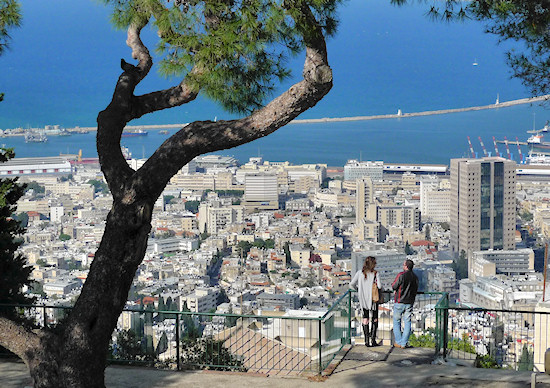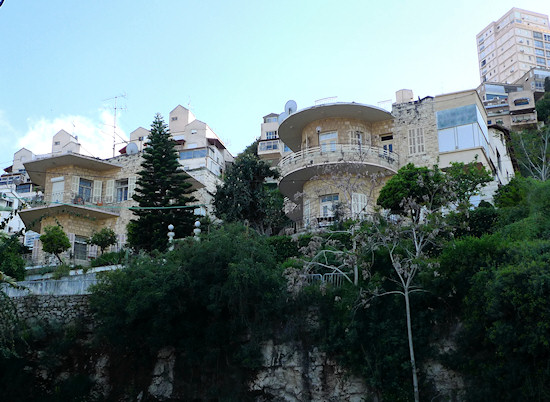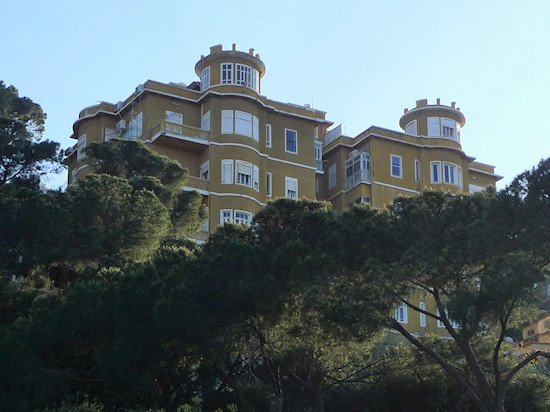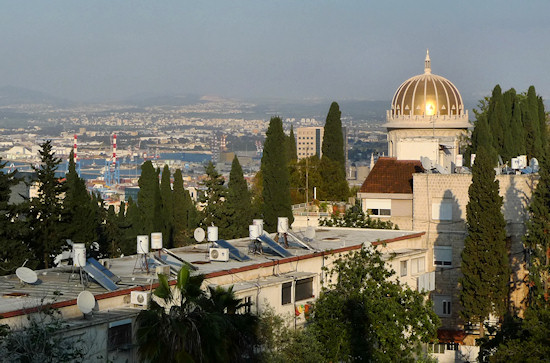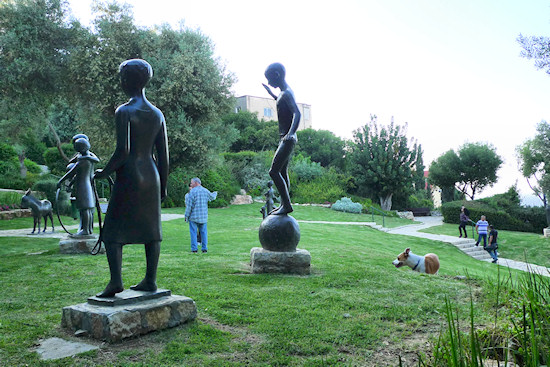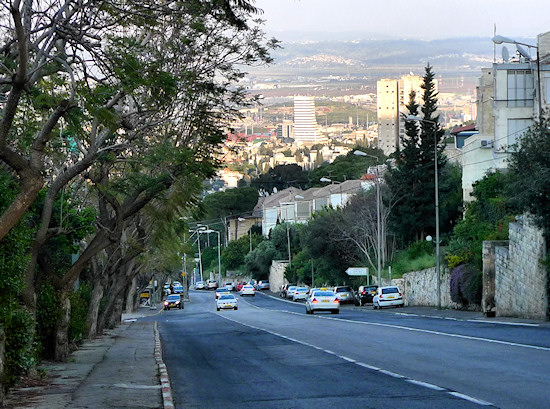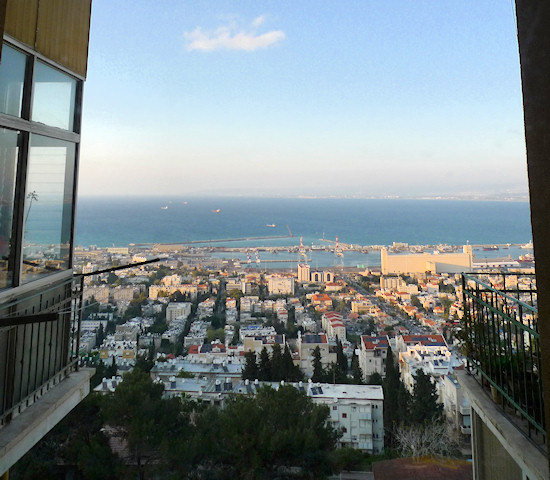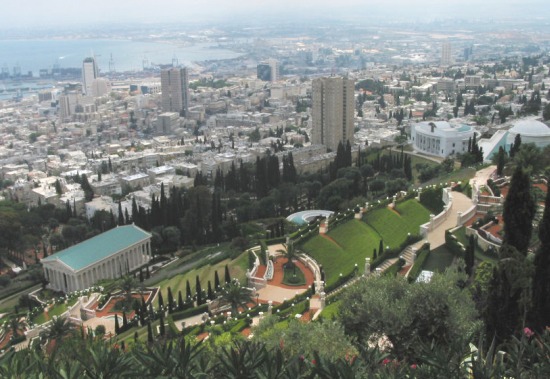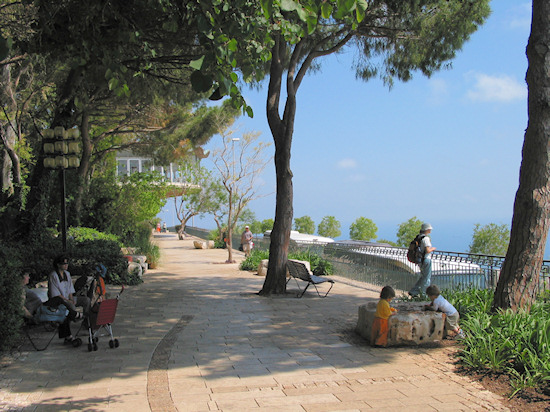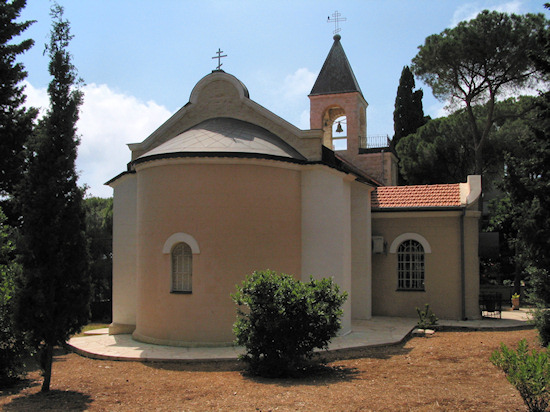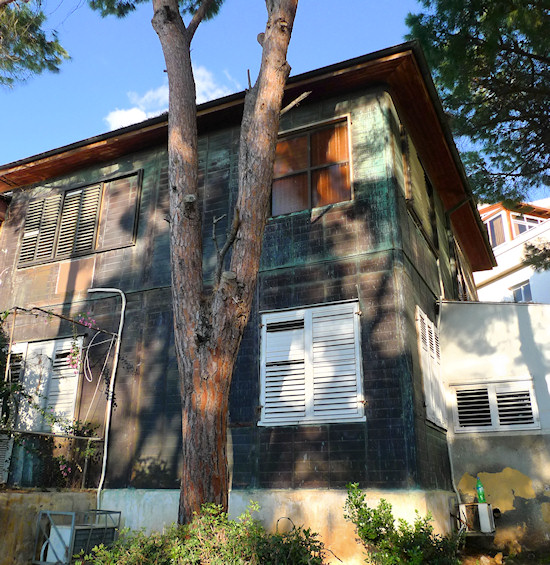Section 19: Gardens and Panoramas in the North-Eastern Carmel | 4.3 Km
Starting point: Stella Maris Rd., Upper Cable Car Station | 140m above sea level
Ending point: Yefe Nof St. Baha'i Gardens Observation Point | 265m above sea level
This section takes in the north-eastern section of the Carmel Ridge, taking advantage of its unique observation points and parks.
The trail begins at the observation point situated at the upper cable car station. Begin by walking down Stella Maris Rd. Stella Maris Rd. was one of the first roads to connect the coast with Mount Carmel. In the nineteenth century, it was under the control of the monks who levied a toll on people using it.
Below is the neighborhood of Kiryat Eliezer with its rows of buildings surrounded by greenery. It was established at the beginning of the 1950s to house port workers.
Before reaching the bottom of the street, turn right into Habishof Hajjar St. The street is named after the head of the Greek Orthodox population who lived in Israel at the beginning of the twentieth century. The trail now takes an upward turn onto the ridge. On both sides, the high-rise buildings present a challenge to the mountain’s substantial inclines. At the roundabout, continue up to Abbas St., which branches off to the right. The street is named after Abbás Effendí, who became “Abdu’l-Bahá”, the disseminator of the Baha’i faith in Israel and the son of Bahá'u'lláh, its founder. After a few meters, a children’s playground divides the street into two. Continue straight up on the right-hand side on Abbas St. After another few meters, the road splits again; turn left to head in a slightly downward direction into Shalhoub Gamil St. Opposite number 9, turn right up the Al Gazali steps. On the left is a metal fence. Turn left, encircling the fence on an asphalt path and then up to the right onto a path that leads to HaTziyonut Blvd (the path twists left before merging with HaTziyonut Blvd.). This road follows the route of the nineteenth-century “Mountain Road” that connected the Carmelite compound with the Old City.
The trail now passes near the entrance to the site most clearly identified with Haifa – the Baha’i Temple – easily identifiable by its golden dome. The temple is dedicated to Sayyid Ali Muhammad – the “Bab” – the founder of the Baha’i religion. The temple was designed by the Baha’ian Canadian architect William Maxwell in the eclectic style and constructed between 1949 and 1953 from materials mostly imported from Italy. The temple is surrounded by a beautiful garden that is open to the public (it may be visited as part of Section 20 of the trail that passes the garden at the bottom of HaTziyonut Blvd.).
Continue up HaTziyonut Blvd. Turn right into Shnaim Benovember (November 2nd) St. Immediately on the left is an iron gate; on the other side of the gate is a sculpture garden, one of the city’s most magical gardens with bronze sculptures by Ursula Malbin. From the sculpture garden is a wonderful view of northern Israel. Walk up the path that twists through the garden and leave through the western gate that leads to the upper part of HaTziyonut Blvd.
Continue up and cross HaTziyonut Blvd. on the nearest pedestrian crossing. Still continuing up, turn left into HaNassi Blvd, where the sign points to the center of the Carmel, and then take the first left into Yefe-Nof St., one of the city’s loveliest streets. The term “yefe nof” (“beautiful view”) appears in the Book of Psalms. Some miss its original name – Panorama St. Notice, also, the street’s pleasant residential buildings. Take a look at “Beit Tenenbaum” on the corner of HaNassi Blvd. and Yefe Nof St., which is constructed in the International style. Further on, at the top of the street, are several buildings which, have been constructed in a variety of styles: number 16 is built in the Arab style and number 19 in the eclectic style.
Turn right into Hursha St. Further on, cross HaNassi Blvd. to continue on Hursha St. At number 6, it is surprising to discover a pleasant yard where a 19th century Russian Orthodox church stands in seclusion.
At the roundabout, turn left into Hatishbi St. for another surprising discovery – a private home whose walls are comprised of copper panels. Haifa has several similar buildings that were originally owned by German Jews who were forbidden to immigrate with money but permitted to bring goods.
Continue on Hatishbi St. in an easterly direction and turn left into Iris St. that leads to HaNassi Blvd. Turn left and immediately cross and enter Dafna St., which leads back to Yefe Nof St. Turn right up the street where again a view north opens up; below is the manicured slope of the Baha’i Gardens.
Number 45 Yefe Nof St. is the starting point for guided tours of the upper part of the gardens. The Baha’i religion is an autonomous, monotheist faith whose guiding principles are unity and equality between religions, nations, races, and people. The Carmel is sacred to the Baha’is because of the vision of its founder, Bahá'u'lláh, and situated on it are the faith’s most important institutions: the world justice center, the center for international consultation, the center for the study of Holy Scriptures, and the international archive.
The gardens are the most recent addition to the Baha’i institutions on the Carmel and were inaugurated in 2001. They spread over an area of 400 square meters on the slope of the mountain. Eighteen terraces bridge an elevation difference of 225 meters and 100 gardeners cultivate the gardens every day – not trivial work, particularly for those whose task it is to mow the lawns. The general public accesses the gardens from the top, walking down, while for Baha’i pilgrims, access is from the bottom up; their climb upwards symbolizes the elevation of the soul on its way to the temple.
Continue up Yefe Nof St. to the spectacular observation point over the gardens. During the day it is possible to enter and visit the upper terrace, but even when the gates are closed visitors can gaze upon what is considered one the most beautiful and admired viewpoints in Haifa.
English translation by Roberta Neiger sponsored by the social hub for community & housing, Faculty of Architecture and Town Planning, The Technion
